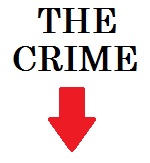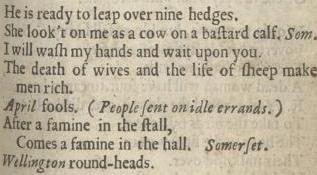
Posts by MikeSutton:
- Selby cited Matthew’s book many times in 1842 and then went on to edit Wallace’s (1855) Sarawak paper – which Darwin also read pre 1858. Darwin and his friends knew Selby very well. Darwin sat on committees with him and his father and friends had even stayed at Selby’s home – where Matthew’s book sat in the library.
- Chambers cited Matthew’s book in 1832 and then in 1842 wrote ‘The Vestiges of Creation‘ the best seller on evolution that was Wallace’s greatest influence and a great influence on Darwin for famously putting evolution “in the air” in the first half of the 19th century. Darwin was a friend and correspondent of Chambers. And Lyell was a member of the same Geological society as Chambers and heard him speak on more than one occasion. It is well known that both Darwin and Lyell knew that Chambers was the anonymous author of the heretical Vestiges.
- 1871 Von Wolff’s bad science exaggerated spinach iron content
- 1892 – Switzerland – the German Von Bunge gets it right
- 1907 – USA – Sherman explains 19th Century bad science
- 1920 – Germany – Noorden & Salomon still citing old German bad science
- 1972 – UK – Bender publishes spinach Popeye iron decimal error myth
- 1981 – UK – Hamblin braces Bender’s myth
- 2010 – UK Sutton proves Popeye ate spinach for vitamin A and never for iron
- 2010 – UK Sutton busts spinach iron decimal error myth – Proving that some German chemists had it wrong in the 1920’s, whilst the German Von Bunge and American scientists had it right much earlier. later it is possible that Popeye comic strips and movies might have accidentally confused the public about spinach being a good source of iron.
- 2011 – UK Sutton shows that US spinach production did indeed increase by 33 per cent in 1936
- Innocent Knowledge Contamination: The spread of unique ideas from Matthew’s 1831 book via (a) other published sources on the topic, which failed to cite Matthew as their source, (b) word of mouth and/or correspondence to Darwin by those who read Matthew’s book – understood its importance in whole or simply in part – but failed to tell Darwin about the existence of the book.
- Reckless or Negligent Knowledge Contamination: (a) Darwin read Matthew’s book, absorbed many ideas and examples and terms from it, but forgot all about having read it – and never did remember (b) read it and took notes but forgot the source of the notes, (c) was told about ideas from Matthew’s book by someone – who understood their importance in whole or simply in part – told they came from a book, but failed to ask the name of the author and book.
- Deliberate Knowledge Contamination (science fraud): Darwin read Matthew’s book, took copious notes, remembered what he had done but always pretended otherwise.
Wolf versus pigs Crimes Fairy Story Shows why Crime Reduction Policy Making is Based on Absurd Pseudoscience
October 24th, 2015– By Mike Sutton –
The Routine Activities Theory (RAT) notion of crime opportunity is almost universally accepted within criminal justice and academic communities as one of the most important explanations for crime and is used as a framework for crime reduction policy making. But the RAT notion of opportunity is, in fact, absurd because it considers opportunities to be foregone conclusions rather than contingent circumstances that must first be perceived to be successfully or unsuccessfully capitalised upon. In short, logically and rationally, all opportunities have to be perceived and are contingent on expected and unexpected events.
An opportunity cannot exist for you unless you personally perceive it as the coming together of a set of fortunate or otherwise potentially beneficial circumstances/events upon which you can choose to act.
So the entire definition of a personal opportunity is based on the premise that benefits and a person’s (or animals/plants) capabilities to secure them are in some way perceived by them. And perceived opportunities are always subject to expected or unexpected beneficial or detrimental contingencies.
Where crime is concerned, a potential offender can have a pre-crime accident, get injured or otherwise thwarted during a criminal attempt. The capabilities of any guardian can never be fixed (known) in advance of a crime happening. Even the little piggy in the house made of sticks might have leaped out of his demolished house at the very last minute and poked the wolf in the eye with a broken twig. Check out the hundreds of newspaper stories of have-a-go heroes if you doubt this.
Always expect the unexpected until the crime is completed
Unexpected Contingent Event: Pig Eats Wolf!
And the wolf coming down the chimney in the house made of bricks could have spotted the boiling turpentine and braced his legs above it, bounded over it and ate the piggy. The piggies guardianship capabilities and the wolf’s capabilities can never be known (fixed) in advance as the RAT model would have it. They do not exist in a fixed position, like a mountain or a home, until the crime is completed (including the crime of criminal attempt). Criminal opportunities cannot exist unless perceived and are contingent on both the expected and unexpected. If you doubt this then just consider the numerous cases of burglars getting stuck down chimneys – or alternatively –electrocuted trying to steal copper cable.
(C) Dr Mike Sutton. Crimes Ink. Foxed Books.Used only with express written permission
Crime: You never quite know what will happen until its happened
Felson’s paradigm of crime opportunity is a mere description of the data of a successfully completed crime or completed attempt. Descriptions can not explain themselves. For that, we need a testable hypothesis that is either right or wrong. Felson’s theory is a mere truism masquerading as causality.
Just as even the most elegant description of a fossilized dinosaur found in the geological strata cannot explain why it is there, neither can Felson’s RAT model of opportunity explain successful crimes, failed criminal attempts and prevented crimes.
To explain dinosaurs we have Patrick Matthew’s theoryof macro organic evolution by natural selection (the one Darwin plagiarized). To explain crimes in terms of opportunities, we need a similarly potentially refutable and – if refuted – hard to vary theory. Felson’s theorem is not refutable because it’s a mere truism in the form of a mere description. In terms of the potential of natural selection to be refuted, we need to find only one case of (for example) a human in the strata below a dinosaur. It’s bold ability to be so easily refuted is what makes it such a powerful theory and good explanation.
A barrier to more effective crime reduction knowledge progression has been thrown up by two criminology theories/approaches: Situational Crime Prevention (SCP) and Routine Activities Theory (RAT). The problem is caused by the policy-oriented popularity of SCP and RAT that is likely due in no small part to their simplistic and easily comprehendible, compelling, yet ultimately illogical weird focus upon describing the data of crime in ever more complex ways so that simple truisms about the scenes of successfully completed crimes and failed attempts (crimes of attempting to commit a crime) are placed in the spotlight and presented as a root cause of crime. Felson’s simplistic notion of opportunity is, in fact, merely the very data that a true, testable, theory of causation could explain.
Click here to read my longer online article that explains why.
Expect the Unexpected and it Becomes the Expected Unexpectancy
My explanation for why the RAT notion of opportunity (Ratortunity) is a mere truism masquerading as causality is published in a peer-reviewed essay (here).
Conclusion
if opportunity knocks and you don’t hear it then it’s not an opportunity for you. Meanwhile, above the quantum level – where the future cannot affect the past through spooky wave-particle physics – Ratortunity sucks as a causal explanation for crime!
The Classic RAT Crime Event as Used to Underpin Crime Opportunity Theory Notion Of the Elements in the Crime Opportunity
Comments Off on Wolf versus pigs Crimes Fairy Story Shows why Crime Reduction Policy Making is Based on Absurd Pseudoscience
New Data turns Darwinism into just another silly worship cult
October 4th, 2015– By Mike Sutton –
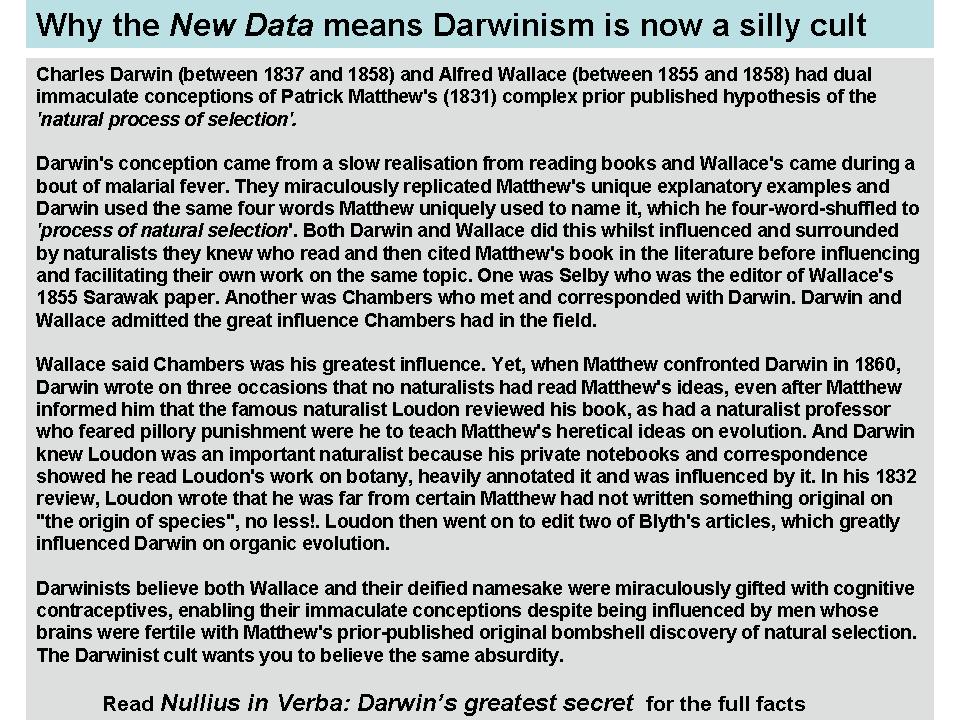
Comments Off on New Data turns Darwinism into just another silly worship cult
Are Computer Games the Real Cause of the “Great Crime Drop”?
September 24th, 2015By Mike Sutton.
Following an original BestThinking blog from five years ago (Sutton 2010), an idea is really catching on at last.
Because Zoe McKnight: (2015) writes in Maclean’s Magazine of Canada about research I conducted with my colleague and friend Professor Mark Griffiths of Nottingham Trent University in England, into the cause of the “Great Crime Drop” in Western industrialised nations over the past two decades.
The real reason crime is falling so fast: How social media obsession, smartphone addiction, and even violent video games are, surprisingly, making us safer
‘…digital preoccupation has been the focus of a multitude of studies, by neurologists, sociologists and psychologists. A few years ago in the U.K., criminologist Mike Sutton and psychologist Mark Griffiths, who studies gaming and addiction, first realized the extent to which their fields overlap. So together, they came up with what they call the crime substitution hypothesis, which suggests that the overwhelming preoccupation with our devices may have contributed to the crime drop.
Like many British ideas, this one turned up at the pub. Griffiths, director of the International Gaming Research Unit at Nottingham Trent University, was having a pint with his friend Sutton, who teaches at the same school. Griffiths had noted the rising obsession with gaming and social media among young people; Sutton had often mentioned the inexplicable drop in crime over roughly the same period. That conversation resulted in a research paper proposing the crime substitution hypothesis.
The theory goes like this: Crime requires an offender with the motivation and ability to act—to go out and “nick” things—as well as a suitable victim, and the absence of someone who can prevent the crime from happening. This means that if substantial numbers of young people are inside and not on the streets, they are less likely to become either offenders or victims. These incremental changes in lifestyle from moment to moment can add up to significant shifts in society.
Though Griffiths admits their theory is “speculative and correlational,” and still requires much research to confirm, it does have what he calls “good faith validity”—it rings true. People his age and his children’s age have an almost pathological need to look at their phones when the devices buzz with an incoming text, Facebook message or email. “The bottom line is, if teenagers are so engaged in social networking or playing their computer games, they can’t physically do two activities at one time,” Griffiths says. “If you’ve got great millions of children in whatever jurisdiction playing online, particularly during their leisure time, this is a time they can’t possibly be engaged in crime, as well.”
If offenders are spending less time on the street then less opportunity for crime will be perceived on the street and the multi-cycles of crime and drug addiction will be reduced.
Comments Off on Are Computer Games the Real Cause of the “Great Crime Drop”?
The Wainwright Alien Particles: A News Update
July 14th, 2015– By Mike Sutton –
This blog post conveys a message in the form of a minimally edited news brief sent to me by Professor Milton Wainwright of Sheffield University, England, following my first blog post, on this topic Best Thinking, about his team’s incredible discoveries in the stratosphere.
Hi. Thank you for showing interest in our work.
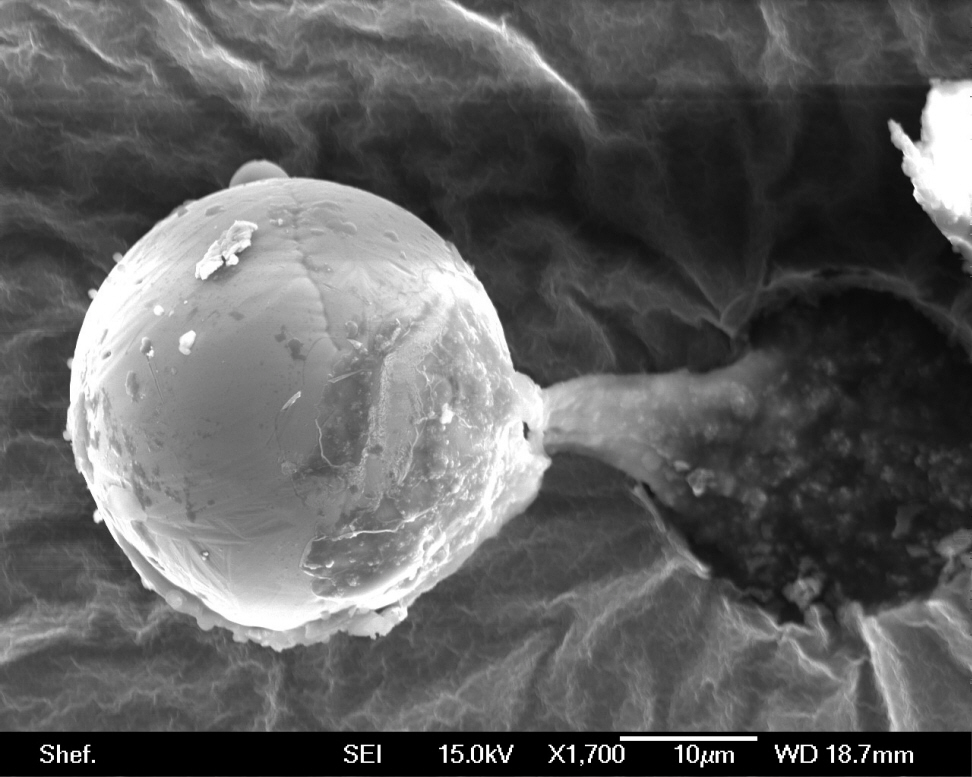
As you can imagine, we are getting considerable interest, so I have put together a reply on our current progress. I hope this latest news answers your queries,
We have been on a roller coaster since we were last in contact. We have had five launches, three of which have been successful. We continue to isolate unusual organisms from the stratosphere. We are now extremely confident that they come from space based on the following:
1) Although very small, physics tells us that they are too large to have been elevated from Earth to space.
2) The organisms appear on the sampler without any contaminating pollen or grass particles. Our critics need to tell us what mechanism filters out such contamination, only allowing our organisms to reach the stratosphere, if they coming up from Earth?
3) Some of the organisms cause impact events (i.e..,they damage the surface or cause craters) on the sampler showing that they are coming into the stratosphere at speed (from space) and are not lazily floating up from Earth.
4) X-ray analysis (EDX) shows that the particles we collect are not incoming cosmic dust or upcoming volcanic dust, but are organic, i.e. biological organisms.
The work has been published in a peer-reviewed journal (despite what the trollers say) and we can provide referees reports that are highly supportive of our position.
The general scientific community is not, however, engaging us in discussion on this work. I have offered to give a talk at any major meeting, or institution, where I can be shot down in flames, if we are wrong; as yet no offers! We are, however, getting plenty of media coverage. Some of it is of the little green man variety, despite the fact that we provide only scientific copy.
The situation to date then, is that we continue to find new and unusual organisms in the stratosphere, we continue to provide proven published evidence that these come from space. However, we continue to be ignored by the general scientific community.
NASA has sent up a balloon to the stratosphere. Japanese workers are also doing similar work to ours. And so we expect confirmation of our findings soon.
I worry, however, that NASA will claim credit for the finding.
What follows is just one of the referee’s comments on our paper in J.Cosmol. which obviously has been subject to a process of expert review, despite what the ‘armchair Einsteins’ and internet trolls say!
“This paper has been thoughtfully written and reports a fascinating observation that absolutely must be published and communicated to the scientific community. It represents an important .and challenging finding regarding material rigorously sampled in the stratosphere (at a height of between 22- 27 kilometres) and it has been coupled to some innovative and useful thinking about the possible origin of this material.”
Conclusions and the way forward
Finally, we have been reassessing some earlier work done during our association with scientists at Cardiff and India in 2012 and have found images of stratospheric masses at 41km which stain (using DAPI) positive for DNA. These we believe are too big to be coming up from Earth.
Lately, we have sampling of the Northern Lights in Iceland and found more unusual biological entities.
Our more recent work has been published in the equally respectful and peer reviewed (refereed) Journal of Astrobiology and Outreach.
Regards,
Professor Milton Wainwright FRAS (19TH JUNE 2015)
Challenging mere soft majority view ‘knowledge beliefs’ with independently verifiable and disconfirming hard facts
Note: Professor Wainwright (2008 ) and (2011 ) is the only writer that I am aware of, besides me, (Sutton 2014 ) to have had published a scholarly peer-reviewed academic journal article, which presents weighty, hard-fact, confirmatory evidence in support of (1) Some form of Matthewian knowledge contamination and (2) the possibility/probability that Charles Darwin (1859) plagiarised the prior published discovery of the theory of natural selection from Patrick Matthew’s prior publication of 1831.
Comments Off on The Wainwright Alien Particles: A News Update
The Greatest Cover-Up in the History of Science Exposed by Unique Discovery of New Hard Independently Verifiable Data
June 28th, 2015By Mike Sutton
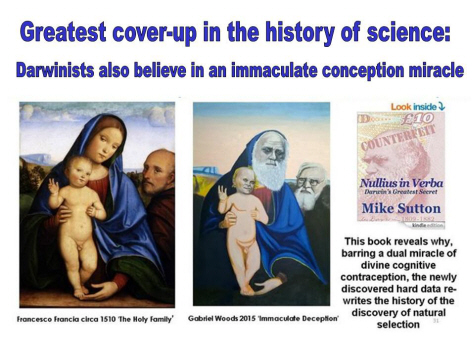
For the background story to this painting, visit Gabriel Woods and Matthew Art .
What has been newly discovered in Nullius in Verba: Darwin’s greatest secret that changes everything we thought we knew about the discovery of natural selection?
Before the publication of my book Nullius, Darwinists simply believed their namesake and Alfred Wallace when each claimed to have discovered the hypothesis of natural selection “independently” of Patrick Matthew’s prior publication of it. They held this mere belief because none had looked behind Darwin’s (1860) excuse for replicating Matthew’s prior published unique discovery that : “I think that no one will feel surprised that neither I nor apparently any other naturalist had heard of Mr Matthews’ views…”
So what did I uniquely discover to prove the rational improbability that either or Darwin or Wallace discovered natural selection independently of Patrick Matthew’s prior publication of the full hypothesis? And what did I uniquely discover to prove Darwin and Wallace were not at all the honest and humble scientists portrayed in the literature – but were instead egotistical self-serving liars?
1. Darwin lied when he wrote in his defense in the Gardeners Chronicle in 1860 that :”…neither I nor apparently any other naturalist had heard of Mr Matthews’ views…”because Matthew told him in the letter to which Darwin responded with that lie that John Loudon had written a review of his book. Loudon – a noted botanist and fellow of the Royal Society and the Linnean Society (amongst others) had been dead 16 years by then. But Darwin knew he was a naturalists because his notebook of books read was jam-packed with Loudon’s books (often heavily annotated). And that same notebook showed that Darwin had held in his hands at least five publications that cited Matthew, two of which were written by Loudon. Not only that, but it is also newly discovered that Darwin’s notebook of books to read and books read showed he owned a copy of an article Matthew wrote in 1829 on hybridizing fruit trees (a topic Darwin wrote about in his private 1837-38 Zoonomia notebook). The article in question is: Matthew, P. 1829. Some Account of the Fruits grown in Gourdie Hill Orchard Carse of Gowrie with Remarks. In a Letter from Patrick Matthew Esq. to the Secretary dated 3. December 1827. Memoirs of the Caledonian Horticultural Society. Fourth Volume. Edinburgh. Maclachlan and Stewart. London Simpkin and Marshall. Moreover, Darwin had his best friend the botanist Joseph Hooker approve his letter containing his lie that apparently no naturalist had read Matthew’s 1831 unique ideas, and then send it on his behalf to the Gardener’s chronicle. Joseph Hooker also knew Loudon was a naturalist. In fact, he had earlier written that Loudon was better than any other in Europe. This is the same Joseph Hooker who had in 1858 worked with Darwin’s other great friend and mentor Charles Lyel to slyly mislead the Linnean Society into believing Wallace had given his consent to have his paper read before them and then published with Darwin’s. Wallace’s paper they read along with (but after) Darwin’s so that it would thereafter be called Darwin’s and Wallace’s theory. Darwin continued his lie that Matthew’s book had gone unread (despite Matthew telling him in his second letter to the Gardener’s Chronicle of other naturalists besides Loudon who had read it) from the third edition of the Origin of species and in a letter to the eminent French naturalist Quatrefages de Bréau (April 25, 1861 ).
2, Had any Darwinists – who society relies upon to tell the veracious story of the discovery of natural selection – not simply swallowed Darwin’s story- hook, line and “Hooker” – noticed Darwin’s great lie that no naturalist had read Matthew’s book pre 1860 then they might have investigated whether or not what Loudon did as a naturalist might be important in the veracious story of the discovery of natural selection. Had they done that then they would have discovered that Loudon did far more than write in his 1832 book review that Matthew may have written something original on “the origin of species”, because they would also have found what I uniquely discovered: namely, that Loudon edited two of Edward Blyth’s influential papers on the evolution of species and varieties of organic life; papers which definitely influenced Darwin – because he wrote from the third edition of the Origin of Species onward that Byth was his most important and prolific informant on the topic.
3. To further uniquely bust the myth that no naturalist read Matthew’s (1831) prior published hypothesis, I uniquely discovered six more naturalists actually cited it in the literature before Darwin’s and Wallace’s papers were read before the Linnean Society in 1858. Darwin knew four of them. And Darwin and Wallace were influenced and facilitated by two of those naturalists.
4. Wallace misled the world in his autobiography by slyly deleting incriminating text in his transcription of his letter to his mother where he had written that following what Darwin, Lyell and Hooker had done at the Linnean Society with his work that he was owed “assistance” by Darwin and his associates. And he did indeed receive a great deal of financial and social “assistance” from them thereafter.
5. Darwin told a further five lies that mislead the world into crediting him with priority over Matthew for the Originator’s unique discovery.
6. Matthew was the first to use the powerfully simple Artificial versus Natural Selection Analogy of Differences to explain the complexity of natural selection. This is probably the most important explanatory analogy ever published in the history of humanity. Loren Eiseley (1979) had earlier discovered that Darwin’s unpublished (1844) replicated Matthew’s (1831) plants grown in nurseries versus those growing wild analogy of differences to explain the operation of natural selection. What none before me picked up on is that Darwin (1859) opened Chapter 1 of the Origin of Species with Matthew’s unique explanatory analogy:
‘When we look to the individuals of the same variety or sub-variety of our older cultivated plants and animals, one of the first points which strikes us, is, that they generally differ much more from each other, than do the individuals of any one species or variety in a state of nature. When we reflect on the vast diversity of the plants and animals which have been cultivated, and which have varied during all ages under the most different climates and treatment, I think we are driven to conclude that this greater variability is simply due to our domestic productions having been raised under conditions of life not so uniform as, and somewhat different from, those to which the parent-species have been exposed under nature.’
7. Wallace replicated that exact same analogy of differences in his 1858 Ternate paper, which was read after Darwin’s before the Linnean Society in 1858.
8. Using new technology of Big Data analysis, I was able to determine – out of over 30 million publications in Google’s Library Project – which terms and phrases in his 1831 book were apparently coined by Matthew and who was then apparently first to be second to use them in print. I discovered many naturalists well known to Darwin and his closest associates who were apparently first to be second with apparently unique Matthewisms. Surprisingly, six out of only 25 people in the entire world discovered in this way were naturalists well known to Charles Lyell. This method also uniquely revealed that Chambers was first to be second to replicate Matthew’s unique term for his discovery ‘natural process of selection’ and that Darwin uniquely four-word-shuffled that term into its only grammatically correct equivalent ‘process of natural selection’, which he used nine times in the Origin of Species (1859). As far as I have been able to ascertain, at the time of writing, before this fact was presented in 2014 in my book ‘Nullius’ no one had noticed that Darwin uniquely four-word-shuffled Matthew’s unique name for his discovery. Had they done so, they might have discovered before I did that Robert Chambers read and cited both of Matthew’s books before going on to influence both Darwin and Wallace, and the rest of the world, on the topic of organic evolution.
and his closest associates who were apparently first to be second with apparently unique Matthewisms. Surprisingly, six out of only 25 people in the entire world discovered in this way were naturalists well known to Charles Lyell. This method also uniquely revealed that Chambers was first to be second to replicate Matthew’s unique term for his discovery ‘natural process of selection’ and that Darwin uniquely four-word-shuffled that term into its only grammatically correct equivalent ‘process of natural selection’, which he used nine times in the Origin of Species (1859). As far as I have been able to ascertain, at the time of writing, before this fact was presented in 2014 in my book ‘Nullius’ no one had noticed that Darwin uniquely four-word-shuffled Matthew’s unique name for his discovery. Had they done so, they might have discovered before I did that Robert Chambers read and cited both of Matthew’s books before going on to influence both Darwin and Wallace, and the rest of the world, on the topic of organic evolution.
9. An electronic plagiarism check reveals many examples of great similarity between the prose and ideas of Wallace and Darwin compared to Matthew’s. But Darwin also replicated Matthew’s unique creative process by replicating his examples of how the natural process of selection works. By way of just two examples in addition to the example of plants grown in nurseries that Eiseley discovered, Darwin also replicated Matthew’s examples of what happens when many seedlings spring up together in a forest. Moreover, he replicated what Matthew cited from Steuart (1828) about cattle eating young trees. .Only where Matthew cited his source about the cattle example, Darwin audaciously pretended it was his own observation in nature. My book Nullius has an entire chapter dedicated to many other uniquely discovered examples of Darwin’s and Wallace’s obvious plagiarism of Matthew’s book.
10. Nullius uniquely contains the ‘Virgin Darwin Allegorical Analogy Explanation ‘, which Is particularly designed for Darwinist atheists. In effect, the analogy is that we know the Virgin Mary of Christian belief was surrounded by men whose testicles were to some unknown degree fertile. And it is for that reason that her mythical conception of the child of a supernatural sky-dwelling deity (“God”) is a supernatural miracle. Analogously to the Blessed St Mary, so too do we newly know that, pre-1858, Darwin and Wallace were surrounded and influenced by men whose brains were fertile to some unknown degree with Matthew’s unique ideas – because those men had read and then cited his book and they are known influencers of Darwin and Wallace. It would, therefore, be a supernatural miracle, perhaps granted by some divine invisible cognitive contraceptive, for both Darwin and Wallace to have immaculately conceived Patrick Matthew’s prior published unique complex theory of the natural process of selection, his four words to name it, his analogy to explain it and even his unique and idiosyncratic examples of its operation in nature.
Darwinists, unconvinced by the strong new evidence for Darwin’s and Wallace’s work being contaminated by Matthew’s influence, and similarly unconvinced by the further evidence for their science fraud being more likely than not, insist that we must – in order to convince them – find in the decimated archives of the 19th century a “smoking” gun letter from or to Darwin and or Wallace revealing that they definitely knew about Matthew’s unique ideas pre-1858. By rational retort, the lesson of the ‘Virgin Darwin Allegorical Analogy Explanation ‘ is to ask them a most telling question: “Why then do you not insist on us finding a 2000 year old paternity admission letter from the human biological father of Jesus of Nazareth in order to be convinced that it would be a miracle for Jesus to be the biological son of the Christian ‘God’?” The answer is because Darwinists already know that it is outside the realm of current scientific experience and understanding for women to conceive a child without the presence of male human sperm. Can Darwinists, therefore, show us one example in the whole of human history where a complex prior published theory has been immaculately conceived by another human (never mind two at the same time) whilst surrounded, facilitated and influenced by others who read it before influencing them, corresponding with them, meeting with them and their family and other friends and influencers and facilitating their work? Of course not. Darwinists are, therefore, being completely irrational by denying the strength and great importance of the new data inNullius. It seems they do not love science and reason at all.
Conclusion
In addition to these unique discoveries, which mean highly influential knowledge contamination from Matthew to Darwin and Wallace is now rationally proven far more likely than not, I have uniquely unearthed a plethora of clues as to where to look next for printed or hand-written 19th century confirmatory evidence that the author or recipient of as yet undiscovered “smoking gun” text was Darwin or Wallace; or else where to look next for such documentary evidence that reveals that they knew by reading or else writing it that Darwin or Wallace was aware of Matthew’s book pre 1858. Namely, in the correspondence, notebooks, published and unpublished work, and private diary archives of those I discovered cited Matthew’s (1831) book before 1858, or else were apparently first to be second with apparently unique Matthewisms before 1858 – and also in the diaries, notebooks, published and unpublished work and private correspondence archives of their friends and associates. Let us call this Sutton’s New Data Hypothesis. And let it be noted boldly here for the historical record that I am publicly inviting other scholars to be guided by the names uniquely unearthed in my book Nullius in Verba: Darwin’s greatest secret to go out into the field and test it. I do this just as Matthew (1831) invited other scholars to test his own unique hypothesis of the natural process of selection by their observations and experiments.
A Note of Rational Caution: Absence of Evidence is not Evidence of Absence
Professional Darwinists, as natural scientists, are perhaps particularly unsuited as a group to objectively and logically assess the evidence for their namesake’s plagiarizing science fraud. There is, obviously, the first great handicap they carry, which is that Darwinists are named for the man they would try to objectively investigate. More so, however, is the problem that these scholars repeatedly confuse Darwin’s private notebooks and letters as some kind of objective fossil record of what he did or did not do or know.
Darwin – like all of us – was no robot. Consequently, he did not write down or record everything he did or knew. Darwinists themselves know this – when it suits them – because they know that Darwin never could tell his publisher – who demanded to know – where exactly he found the term ‘natural selection’ in the literature. Darwin could only write. fallaciously, that the term was in abundant use in the literature. Moreover, Darwin’s Darwinists even refer to some of Darwin’s most important private documents as his “torn apart notebooks”. And many have remarked on the extent to which letters in the Darwin archive are simple “missing”. In reality, it is no secret that much of Darwin’s correspondence – and letters he received – are “missing”. Wallace’s original Ternate paper is “missing”. Darwin tore his own notebooks apart and ripped out many pages from his notebooks. What those pages contained we will never know. Darwin habitually rendered whole sections of his own handwriting illegible by scribbling over it. Relying therefore on the insensible argument that what survives of Darwin’s letters and notebooks show that he slowly and independently of Matthew’s prior published book discovered the bombshell hypothesis of natural selection is just plain silly. Darwinists do themselves a great intellectual disservice by relying upon such daft-as-a-brush reasoning as some kind of strong evidence that their namesake arrived at the theory of natural selection independently of Matthew, because we now newly know that both Darwin and Wallace were influenced and facilitated pre-1858 by naturalists who they knew – who they said were a great influence upon them – who had cited Matthew’s 1831 book, containing the full theory of natural selection , in the literature before 1858 (Chambers) and by another (Blyth) whose editor (Loudon) had reviewed it and remarked on its originality on the topic of “the origin of species” and by Wallace’s own Sarawak paper editor (Selby) who sat with Darwin on various scientific committees many times pre 1858 and had both Darwin’s father and his great friend Jenyns as house guests – where Matthew’s book sat in his library, having been purchased for him in 1840 by the great and influential naturalist Jardine – no less.
To be kind, the least we can say now is that any Darwinists claiming in their namesake’s defense that this new evidence is weak are being irrational. In the name of reason, the new evidence is so strong it logically renders all previous evidence for Darwin’s and Wallace’s so called dual “independent” discoveries of Matthew’s prior published hypothesis not just weak but completely insensible.
The problem, however, for veracity in the history of science is the same as James Randi famously explained about those who believe in the paranormal and other debunked and otherwise un-evidenced nonsense:
“The public really doesn’t listen when they are being told straight-forward facts. They would rather accept what some charismatic character tells them than really think about what the truth might be. They would rather have the romance and the lies.”
The general public, by simply believing the words of those charismatic Darwinists posing as skeptical scientists and educators, writing scholarly books and articles that teach their now debunked fallacies about the history of Matthew’s book, have fallen into the exact same trap as credulous punters at a spoon bending séance.
This post explains exactly what has been uniquely discovered and revealed in my book ‘Nullius in Verba: Darwin’s greatest secret. This is the information that professional Darwinists did not and do not want you to know about, because it 100% proves that, as individuals and as a group, for the past 155 years, those named after their science hero have been churning out absolute credulous ‘deifying Darwin’ nonsense about the discovery of natural selection. By way of just one telling example amongst many I could cite, why else would Darwin’s apparently adoration-blinded biographer James Moore proclaim to his eternal shame when asked to comment on my book, which he had not even bothered his biased brain to read : “I would be extremely surprised if there was any new evidence had not been already seen and interpreted in the opposite way.”
In reply to Moore: I would be extremely surprised if he, a professionally biased Darwinist with so much at stake following his own career failure to look any further than the unfounded self-serving lies penned by Darwin for his own replicated fallacious ‘knowledge beliefs, ever engaged with the hard new facts, which I have uniquely discovered. The new hard facts of the matter are that Charles Darwin is now, as a result of my original 100% independently verifiable and important discoveries, a proven liar who far more likely than not knew about Matthew’s unique ideas pre-1858 and was influenced by them. Contrary to widely published Darwinist fallacies, both Darwin and Wallace are newly proven by my work to have known naturalists who read Matthew’s book containing his prior published hypothesis of natural selection before they influenced them on the exact same topic and before Darwin and Wallace each replicated the hypothesis, so many ideas, explanations and unique explanatory examples that were uniquely first published in Matthew’s (1831) book. I suggest Moore write his next book on the Semmelweis reflex so that he can understand his own role in demonstrating it, but not before he has studied the fact of its namesake’s mythology.
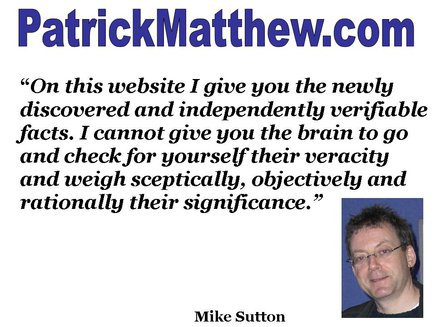
PatrickMatthew.com
Comments Off on The Greatest Cover-Up in the History of Science Exposed by Unique Discovery of New Hard Independently Verifiable Data
Professor Milton Wainwright Discovers Alien-Life Particles
June 9th, 2015By Mike Sutton.
Milton Wainwright, Professor of Microbiology with an esteemed international reputation in his field, is employed by Sheffield University in England.
He is making news headlines everywhere regarding the particles his research team has found in the stratosphere . Professor Wainwright claims they are of extraterrestrial origin.
Amazingly, one of particles, no thicker than a human hair, closely resembles the s-type comet Ida. which is considerably larger – measuring 58 x 23 kilometers (or 36 x 14 mi).
Ida was the second asteroid to be observed close up by a spacecraft, when the space probe Galileo took pictures as it flew by on Aug 28, 1993.
These pictures of Ida showed not only that it has a cratered surface, but also that it has a small moon called Dactyl, which is about 1.6 x 1.2 km in diameter and orbiting 90 km away from the asteroid.
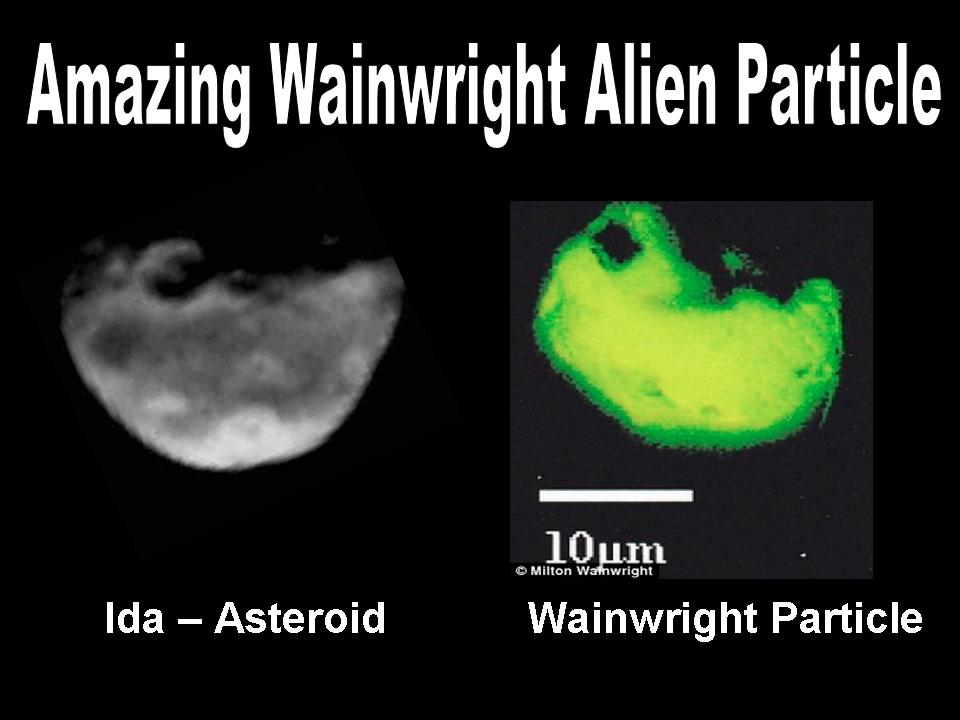
Further details, including one spherical particle with a titanium shell that Wainwright claims is evidence of intelligent design engineering, can be read and seen on my best thinking blog – here
Comments Off on Professor Milton Wainwright Discovers Alien-Life Particles
Historic Tweet Tells World Unmarked Grave of Scottish Science Hero Patrick Matthew is Finally Discovered
June 5th, 2015By Mike Sutton
It has long been known that the Scot, Patrick Matthew, the only true originator of the theory of natural selection, was buried in what is now an unmarked grave in Errol
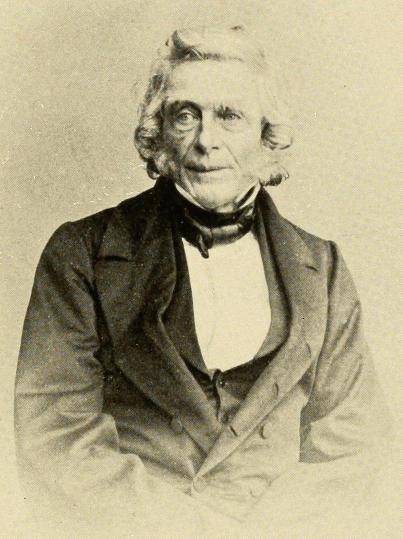
Churchyard in the Carse of Gowrie, Scotland. However, the location of his exact, unmarked, grave has been a mystery for over 100 years.
Others, including Jim Dempster and Matthew’s descendants looked for it in the churchyard but were unable to locate where the great man was laid to rest.
Matthew Refuses to be Buried in Oblivion!
On 23 May 2015, we finally found out where to go and pay our respects to the man who uniquely discovered the most important theory in the history of science, because Matthew’s grave has been located by Peter Symon, an obviously very able British researcher working in the field of urban design history.
Symon very kindly sent me a Twitter message letting me know the details of his soon to be famous discovery.
Peter Symon’s historical tweet, pictures of the grave site in Errol Churchyard, Scotland, and further details including an image of the burial record can be found on my BestThinking blog
More details about Matthew can be found on the Patrick Matthew Website PatrickMatthew.com
Comments Off on Historic Tweet Tells World Unmarked Grave of Scottish Science Hero Patrick Matthew is Finally Discovered
Artist Paints Satirical Portrait as Analogy to Explain Charles Darwin’s Science Fraud
May 24th, 2015
By Mike Sutton.
This oil painting, by the Nottingham based British portrait artist Gabriel Woods, showing Darwin holding Patrick Matthew as his own child. Paying homage to religious pictures of the Virgin Mary and child, this is a mesmerizing pictorial analogy of Darwin’s and Wallace’s claims to have each conceived the theory of natural selection independently of Patrick Matthew’s (1831) prior published book, which expert Darwinists agree contained the full theory 27 years before Darwin’s and Wallace’s papers were read before the Linnean Society in 1858.
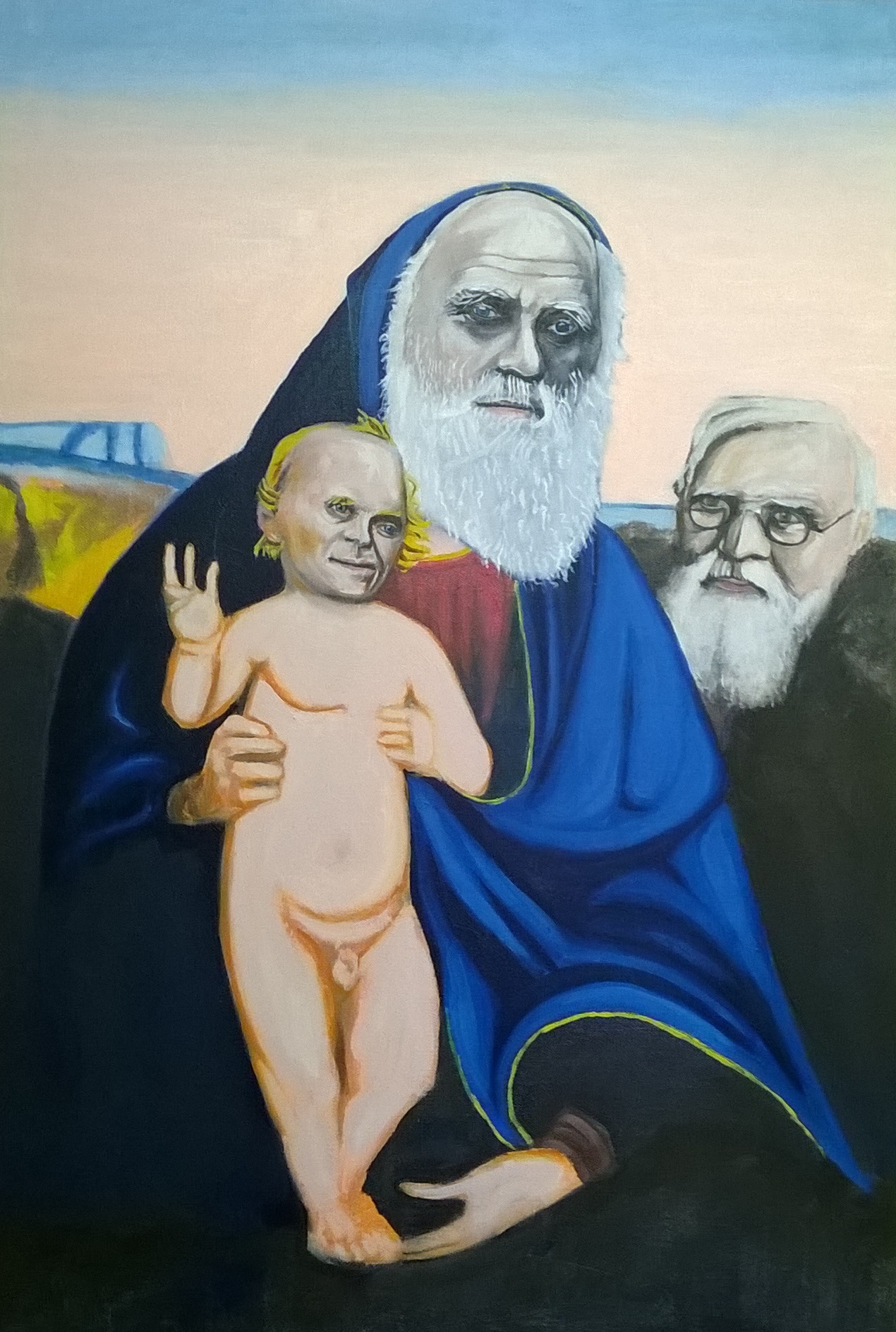
“Immaculate Deception” is a painting after “The Holy Family” by Francesco Francia, 1510.
In the words of the artist Gabriel Woods (May 2015) by way of explanation for his portrait “Immaculate Deception”:
“The picture represents Charles Robert Darwin and Alfred Russel Wallace who both claimed, they each independently discovered the theory of natural selection with no prior knowledge of Patrick Matthew’s earlier work. Patrick Matthew is represented in the allegorical painting as the infant “
The picture was commissioned, in light of new data (Sutton 2014) that proves naturalists well known the Darwin and Wallace read and then cited Matthew’s book before going on to play roles at the very epicenter of influence on the pre-1858 work of Darwin and Wallace on natural selection. The Blessed Virgin St Mary’s conception of Jesus of Nazareth, is a miracle because she became pregnant with the child of “God” whilst surrounded by men who were fertile to some unknown degree. The analogy is perfect because so too were Darwin and Wallace surrounded by man whose brains were fertile – to some unknown degree – with Matthew’s unique ideas. Therefore, in the final analysis, if Darwin and Wallace did not conceive Matthew’s unique discovery, name for it, examples of it in nature, and his artificial versus natural slection analogy of differences to explain it, by some kind of ‘knowledge contamination,’ then they must surely have each been mysteriously endowed with a miraculous and divine cognitive contraceptive device.
Further details on this story can be read on the Best Thinking websiite
Comments Off on Artist Paints Satirical Portrait as Analogy to Explain Charles Darwin’s Science Fraud
Breaking News: Nicola Sturgeon is Actually a Woman! Duh!
May 8th, 2015By Mike Sutton
Contrary to a report to the contrary here on The Daily Journlist The Leader of the Scottish National Party is actually a woman! The shocking news here is that for once

Yet our anonymous DJ correspondent has it:
“Now, as then, Sturgeon (born in Irvine, Ayrshire) usually regains strength in his adopted hometown, Glasgow, where these days there has been a new bathroom Mass: “I am happy to always come back here and see especially so many women no offense to men. “
No offense to men????
The Fallacious Daily Journalist article has Sturgeon swapping her gender at the start – becoming female at midpoint – then back to male. What on Earth is going on?
Nicola Sturgeon plans his assault Westminister
The Daily Journalist.
The independence leader Nicola Sturgeon in London plans to captain a ‘task force’ Scottish ministers and MPs to force a deal with anti Cameron Ed Miliband, the Labour leader even if he loses the election on May 7. The premier has denounced the move beforehand and warned that a Labour Government, with the votes of the SNP and without having the largest number of deputies would be “legitimate” and would have “a massive credibility problem.”
In the final hours of the British campaign, the political epicenter again will move to Scotland. All reflectors point in these times to Sturgeon, in their comings and goings by helicopter (the now famous Nicolópter), while their rivals waged the final battles for control of key districts in England.
In Scotland, the battle will be decided in a while. The only question is whether the Scottish National Party (SNP) will get all of the 59 seats at stake (out of 650 in the UK) and completely sweep away national parties map, beginning with Labour, which does just five years were the majority party. The new position of strength of the SNP is being harnessed in advance for Sturgeon, the head of which will be from Friday the third British party. “The real ‘test’ of legitimacy is whether a government can build a majority that reflects not only the most voted party in England,” said the nationalist leader. “The British MPs will always be the biggest part a majority in Westminster, but ignore the Scottish voices be a mistake.”
All parties have already launched their post electoral machinery to move parts in the light of the first results. Most projections awarded a victory by the minimum of the Conservative Party, but the Labour Party and the SNP could achieve together enough votes to launch a confidence motion and force out Cameron Downing Street.
However Ed Miliband leads avoiding the bull “coalition of chaos” (as named Cameron). First he denied the possibility of having “independence ministers” in his cabinet, then he refused to sign an “agreement of trust” with the SNP and the end has rejected the possibility even “talks with a separatist party that wants to break the country” (Speaking to BBC radio).
Scottish minister continues however main press and will move to London in person within hours of learning of the official result, sheltered by a retinue of his own cabinet, the number two SNP Stewart Hosie and former independence leader-and expected new congressman Alex Salmond, with a “specific mission”, as revealed by The Independent.
“Of course that Labour can give us back,” says Sturgeon. “But if we allow the Tories back to the government, rather than working with the SNP, the Scots do not forgive. I do not think they forgive in other parts of the country. If we can get rid of them, we have to drive them.”
Whoever wins this election, the moral winner is Nicola Sturgeon, the woman who has entered the British political scene with hurricane force, before the incredulous eyes of the ‘old boys club’ (Cameron, Clegg, Miliband), not just to believe how a separatist leader has been so quickly pocketing millions of Britons and beat them in the popularity polls.
Nicola effect was felt mainly in the campaign after the televised debate to seven bands in which he proclaimed himself as the undisputed winner. Since then, touring Scotland on board the ‘Nicolópter’ and driven by a campaign melee with voters (very different from the acts choreographed for cameras rivals), Sturgeon has been gaining presence and claiming their place on the podium .
His rise was seen coming since he took over from his mentor, Alex Salmond, Scotland after the referendum. He is carrying his shadow since 2007, to the point that many considered it as an indissoluble political marriage (it is actually married to another senior party leader, Peter Murrell, which usually go unnoticed by her side).
44 women now comes stomping with their heels, their colorful costumes and his very personal stamp has little or nothing to do with the anti-nuclear campaigner, drawn into the ranks of the SNP as a reaction to the policies of Thatcher, advocate independence as a taboo and a sober in tone and in ways that frightened the political strategists.
In 2007, when it ended (the eighth attempt) his dream of winning an election, she had to undergo intense whitewash. Mission Impossible was dubbed Project -a internally Nicola was also known as Project human being with the idea was to turn serious, robotics and no substance deputy in a potential leader.
She must have seen something in Alex Salmond as he chose as principal deputy minister, for seven years tilling the long road that led to the independence consultation September 18, 2014 and finally Sturgeon launched to stardom, despite the defeat.
Now, as then, Sturgeon (born in Irvine, Ayrshire) usually regains strength in his adopted hometown, Glasgow, where these days there has been a new bathroom Mass: “I am happy to always come back here and see especially so many women no offense to men. “
Comments Off on Breaking News: Nicola Sturgeon is Actually a Woman! Duh!
Busting the Spinach Supermyth: The Skeptic’s Compendium
May 8th, 2015By Mike Sutton
The popular 32 year old myth that a misplaced decimal point in the published results of the iron content of spinach by Professor von Wolff, or else von Bunge, in the 19th century influenced scientists in the 20th century to fail to check the facts and to simply recommend spinach for its over-inflated iron content is finally busted. compendium
Having spent several months of my spare time in 2010 researching turn of the 20th century German biochemistry journals and books on nutrition, I can reveal that several scientists, all working completely independently, came to very similar conclusions. The reason for their exaggerated measurement of the iron content of spinach, and other food, is bad science. They were, amongst several other things, contaminating the spinach in the laboratory with the vessels they used and the charcoal they used to heat it.
The bad science mistake was in fact (contrary to the nonsense contained in the myth) spotted by von Bunge in the 19th century and the fact that such errors occurred was disseminated widely by US Professor Sherman in the early 20th century.
The Spinach, Popeye, Iron, Decimal Error Story (SPIDES) is a myth that was ironically perpetrated by the famous myth busting nutritionist Professor Arnold E. Bender in his inaugural lecture at Queen Elizabeth College, University of London. Arnold E. Bender. Bender first mentioned it in that inaugural lecture in 1972 (Bender 1972) and later in an article in the Spectator (Bender 1977). In the Spectator, Bender started the myth when he claimed that a German textbook on nutrition (Noorden and Salomon 1920; 476) replicated an earlier decimal point data mistake made by generations of textbooks that unquestioningly replicated erroneous data first published in 1870 by the German scientist E. von Wolff:
For a hundred years or more spinach has been (and clearly still is) renowned for its high iron content compared with that of other vegetables, but to the joy of those who dislike the stuff this is quite untrue. In 1870 Dr E. von Wolff published the analyses of a number of foods, including spinach which was shown to be exceptionally rich in iron. The figures were repeated in succeeding generations of textbooks – after all one does not always verify the findings of others – including the ‘Handbook of Food Sciences’ (Handbuch der Ernahrungslehre) by von Noorden and Saloman[1] 1920.
In 1937 Professor Schupan eventually repeated the analyses of spinach and found that it contained no more iron than did any other leafy vegetable, only one-tenth of the amount previously reported. The fame of spinach appears to have been based on a misplaced decimal point.”
Bender’s myth was popularized as being true by Professor Terry Hamblin in the British Medical Journal in 1981 – perversely in an upbeat Christmas article entitled “Fake” about fake academic research. Furthermore, Popeye never ate spinach for iron, his creator E. C. Segar made it the source of his superhero’s strength due to its vitamin A (beta carotene) content.
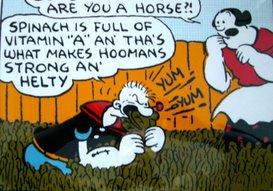
Here is Hamblin’s (1981) new-spin dissemination of Bender’s original spinach myth:
“A statue of Popeye in Crystal City, Texas, commemorates the fact that single handedly he raised the consumption of Spinach by 33%. America was “strong to the finish ‘cos they ate their spinach” and duly defeated the Hun. Unfortunately the propaganda was fraudulent; German chemists reinvestigating the iron content of Spinach had shown in the 1930s that the original workers had put the decimal point in the wrong place and made a tenfold overestimate of its value. Spinach is no better for you than cabbage, Brussels sprouts, or broccoli. For a better source of iron Popeye would have been better off chewing the cans.”
So Hamblin, an orthodox expert, appears to be the first to brace the spinach myth because he did not check the facts behind it. Hamblin has been followed by many orthodox experts all believing the myth to be true and so, with excruciatingly unintended irony, using it as an example of the need to be sceptical of research findings and to check your facts. If ever that old saying “hoisted by your own petard” is very applicable then it is here.
Time Line for Spinach Popeye Iron Decimal Error Myth Busting
My essays on this topic
The full Spinach Decimal Error myth busting story can be read here: http://www.bestthinking.com/articles/science/chemistry/biochemistry/the-spinach-popeye-iron-decimal-error-myth-is-finally-busted
1, The USDA is spreading dangerous ‘bull’ on the Internet. Here: http://www.bestthinking.com/articles/science/chemistry/biochemistry/spin-ge-usa-beware-of-the-bull-the-united-states-department-of-agriculture-is-spreading-bull-about-spinach-iron-and-vitamin-c-on-the-internet
2, Does current USDA erroneous nutrition advice have its roots in a perverse scientific paper written in 1937? Here: http://www.bestthinking.com/articles/science/chemistry/biochemistry/spin-ge-ii-does-the-united-states-department-of-agriculture-s-publication-of-spuriofacts-have-its-origins-in-a-perverse-scientific-paper-written-in-1937-
3. Popeye’s creator chose spinach for its vitamin A content (beta carotene), never for iron. The start of the spinach myth busting. Here: http://www.internetjournalofcriminology.com/Sutton_Spinach_Iron_and_Popeye_March_2010.pdf
On Supermyths
On Supermyths: Their discovery, distinguishing characteristics and significance.
On Hamblin
Professor Hamblin sadly passed away on January 8th 2012. As a immunohematologist, Hamblin was a notable and highly respected and regarded researcher and teacher. He is particularly notable as an early pioneer of stem cell treatment for cancer. He made a difference by making the world a better place.
Comments Off on Busting the Spinach Supermyth: The Skeptic’s Compendium
The Patrick Matthew Supermyth
May 4th, 2015By Mike Sutton.
A supermyth is a myth about a myth, where the second myth is created in an apparent atmosphere of concern to veraciously bust the first myth. What makes supermyths so powerful is that they appear all the more plausible because they are stories about why the first myth came into being and how it was bust.
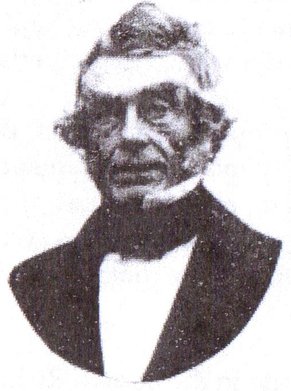
The discovery of the phenomenon of the Supermyth was first published on the Best Thinking website. The Spinach Popeye Iron Decimal Error Point Error Myth (SPIDES) was fully bust in two articles The first here and the second here.
Supermyths have very specific components:
1. The creation of a fallacy, myth or error by an orthodox expert.
2. Being used by another expert who in turn promotes it as being ‘true, and whilst still thinking that it is true either promotes it as a good example of the need to be healthily skeptical of bad scholarship, or else:
3. compounds the myth by using it as a premise upon which to build one or more supporting myths.
The Patrick Matthew Supermyth was created by faux-skeptical Darwinists and other equally credulous members of the scientific community who neglected to apply the scientific principle of nullius in verba to Darwin’s and Wallace’s incredible claims to have independently discovered natural selection with no prior knowledge of Matthew’s prominent publication of it 27 years earlier.
The myth is a supermyth because Darwinists, using natural selection as a mythbusting device for the myth that a God created all species of plants and animals, created the secondary myth that Darwin first discovered the natural process of selection, and that he was first to use artificial selection as an explanatory analogy for the process of natural selection. In fact, Matthew was first to do both.
The myth of Darwin’s and Wallace’s supposed exclusive duel ‘independent’ discoveries of Matthew’s prior published discovery of the ‘natural process of selection’ was bust when it was 100% proven (Sutton 2014 ) that, contrary to the myth started by Darwin in 1860 and 1861, other naturalists known to Darwin and Wallace – who in fact played key roles in influencing and facilitating their pre-1858 work on natural selection – had read and cited Matthew’s (1831) book in the literature. That book – On Naval Timber and Arboriculture – is widely acknowledged to contain the full theory of natural selection (see my RationalWiki essay). The mythbust is best explained to skeptical Darwinists by way of analogy. The Darwin and Wallace Duel Miraculous Immaculate Conception Analogy can be read on BestThinking.com {Here}.
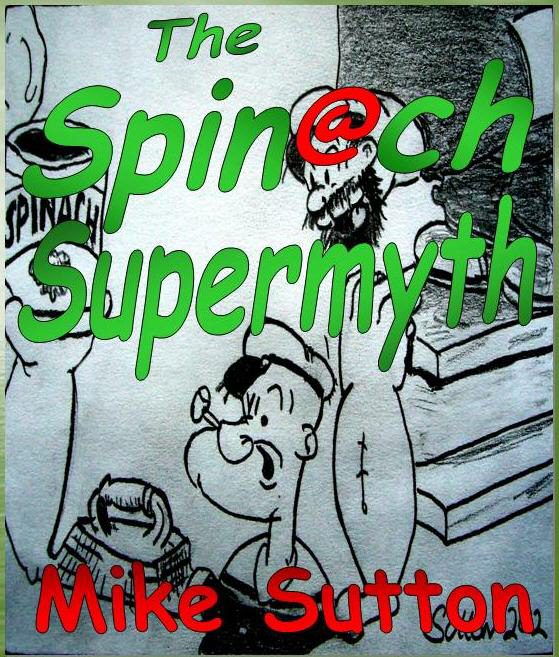 Dysology.com and PatrickMatthew.com
Dysology.com and PatrickMatthew.com Join the Veracity Revolution. Blame it on Google and Follow Supermythbuster on Twitter
Visit the Supermyths website to discover what supermyths have so far been discovered. {Here}.
Find out more about Supermyths by reading my article: On Supermyths: Their discovery, distinguishing characteristics and significance. {Here}
Follow Supermythbuster on twitter {Here} .
Comments Off on The Patrick Matthew Supermyth
Why Darwinists, being mostly biologists, missed the world’s most powerful analogy
April 17th, 2015By Mike Sutton.
Building a little upon the extensive work of the pioneering human transplant surgeon and Darwin expert Jim Dempster, I summarized in my book “Nullius ” what Patrick Matthew originally contributed to knowledge in 1831. I wrote:
‘Matthew originated the concept of Natural Selection in 1831 to explain the emergence and extinction of species between and after geological catastrophic events. He uniquely named it “the natural process of selection”, which he described as a fundamental law of nature. He discussed divergence in terms of diverging ramifications, the mutability of species, rejected miraculous birth of new species following catastrophes, held to a steady state in nature interrupted by catastrophes, understood the importance of the complex multi-level phenomenon of power of occupancy and ecological niches, rejected simple development from nearly-allied species in favour of descent from common ancestor, recognized what constituted a species, recognized the difference between domestic and wild species and saw artificial selection as the key to both discovering and explaining the process of natural selection.’
The last 16 words of the last sentence are rather important.
Dr Mike Weale, senior academic and statistical geneticist at Kings College London and I have spent some considerable time debating amicably whether or not (and if so – to what degree) Matthew’s various comparisons of artificial selection (in terms of humans cognitively breeding by way of selective breeding – animals and plants under protective culture to suit their own needs) with natural selection (the ‘natural process of selection’ in the wild where the most circumstance suited varieties are selected by nature to survive in the wild) is an analogy. The debate was settled on 14th April 2015 on the Patrick Matthew Project.
Essentially, it was agreed that there are actually two main artificial and natural selection analogies that were used in the 19th century by those writing at the cutting edge about their own work that they believe led to the discovery of natural selection.
This is a new understanding in the story of the discovery of natural selection.
In current absence of any disconfirming evidence, the literature record shows that although many others before Matthew (1831) mentioned what artificial selection does, only Matthew used that information in an analogy with anything like any kind of understanding of any of the processes of natural selection to show the differences between the two. Matthew did this as an explanatory device to help readers understand what natural selection was. This was an analogy of differences. Analogies that focus upon difference, as opposed to analogies of sameness or similarities between the things compared come under the broad definition of the term analogy that is provided by the Oxford English Dictionary: ‘A comparison made between one thing and another for the purpose of explanation or clarification.’ We might name Matthew’s unique analogy of Artificial versus Natural Selection: ‘The Analogy of Differences’.
The same unique analogy of differences that Matthew used in 1831 was replicated first by by Mudie (1832), then Low (1844), Darwin (1844) Wallace (1858) and by Darwin again (1859; 1868). See my blog on this story for the full details
The second analogy is the ‘Artificial Compared to Natural Selection analogy of similarities’ that is a comparison of the similarities between artificial and natural selection that Darwin deployed as a far more complex argumentative device in the Origin of Species (1859). For short we might name this one ‘the analogy of similarities’.
It is important to note that as a disciplinary group biologists are remarkable and alone in that the concept of analogy in biology is used only to refer to similarities between one thing and another. I believe that this is why the artificial v natural selection Analogy of Differences has been so under-researched by Darwinists – the majority of whom are – I believe – biologists.
This breakthrough in our understanding of what Matthew originated and Darwin and Wallace replicated, means is that we can now say four things:
(1) Patrick Matthew (1831) was first to publish the complete hypothesis of natural selection.
(2) Patrick Matthew (1831) was also first to use the ‘Artificial versus Natural Selection Analogy of Differences’ to explain the process of natural selection.
(3) Both Darwin and Wallace subsequently replicated both in their major works on the topic; Wallace (1858) in his Ternate Paper and Darwin in his private essay of 1844 and then in the Origin of Species (1859).
(4) Darwin and Wallace each claimed that none known to them had read Matthew’s prior published ideas and that they each independently of Matthew, and independently of one another, discovered natural selection for themselves.
(5) In effect then, Darwin and Wallace claimed to have each independently generated Matthew’s prior published unique hypothesis AND his prior published unique analogy to explain it.
(6) Although Darwin claimed none known to him had read Matthew’s ideas before 1860, BigData analysis uniquely revealed in Nullius in Verba: Darwin’s greatest
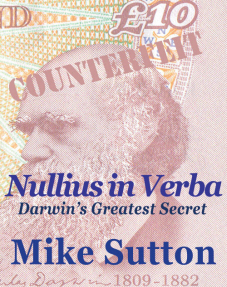
secret (Sutton 2014) that Darwin’s claim is fallacious. In fact, it is newly known, seven naturalists known to him had both read and cited Matthew’s book many years before 1858. Moreover, three of those naturalists were known to be major influences as naturalists, or else facilitators as naturalist editors, on the pre-1858 written work of both Darwin and Wallace on natural selection. By way of another explanatory analogy, this makes Darwin’s and Wallace’s so-called “independent discoveries” of Matthew’s prior published hypothesis, and their replication of his explanatory analogy, like the Virgin Mary’s Miraculous Immaculate Conception of Jesus of Nazareth (see my position paper on this analogy).
This is important, in my opinion. It is highly important because analogies are extremely powerful explanatory devices that have in recent years attracted much attention in the fields of cognitive psychology and neuroscience.
Most importantly, it currently appears (in absence of any disconfirming evidence) that Matthew (1831) not only originated and prior published the hypothesis of natural selection (in a book that we now newly know was, in fact, read and cited by seven naturalists known to Darwin and Wallace), which is arguably the most important scientific hypothesis of all time, but Matthew (1831) also originated the world’s most powerful analogy in order to explain it. Darwin and Wallace replicated both!
Conclusion and the way forward
Does this breakthrough in knowledge, driven forward by a social scientist in collaboration with a biologist, provide confirmatory evidence for the “Frozen Donkey Hypothesis”? I think, to be fair, the answer is a complex story of yes and no. But, in my opinion, Darwinists must adapt to new knowledge or else they will lose their power of occupancy in the literature on the history of discovery of natural selection.
Comments Off on Why Darwinists, being mostly biologists, missed the world’s most powerful analogy
Did the World’s Oldest Easter Bunnie First Hop into English in 1881?
April 5th, 2015By Mike Sutton
As far back as etymological investigation currently takes us down the rabbit hole in Google’s Library of 30 million books, we find the earliest known origin of the Easter Bunny is its forebear the “Easter Bunnie” – which we know branched from its common ancestor the 19th century German Easter Hare.
In the fossil record of books so far scanned by Google, the earliest known example of this lovely creature, beloved of chocolate loving children, bounded into the binding of a book in 1881:
“Cries from all sides resounded of the “Easter Bunnie! oh, let us try to catch him, and see if he has brought us any Easter eggs,”‘
Full details of this seasonal rabbit hunt are available at the Best Thinking site. But, for now at least, it seems that we have found the oldest Easter Bunnie in the world.
Comments Off on Did the World’s Oldest Easter Bunnie First Hop into English in 1881?
Is this the Shocking Origin of “Easter Eggs”?
April 4th, 2015By Mike Sutton
Searching through over 30 million documents that comprise Google’s mighty library project, the earliest currently discovererable use of the term ‘Easter egg/s’ is an old book: Sanderson, W. (1656), A compleat history of the lives and reigns of Maria queen of Scotland, and of her son James VI. Mosely, Tomlins, and Sawbridge. Ludgate Hill (p. 35)
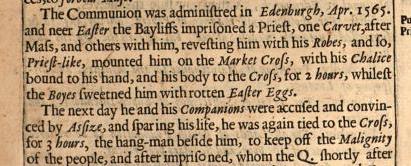
Once again, the revolutionary ID methods unearths something rather disturbing.
Is the published origin of the term Easter Eggs related to an horrendous punishment of a priest – tied to a cross in Scotland in 1565 to be pelted with rotten eggs for hours – two days running? Further research gets us back to an earlier 1572 publication that tells the same story (see update) about the very same priest being “egged” in Edinburgh. Clearly more research is needed ,but it seems we have a tentative “Rotten Easter Eggs Origin hypothesis” in need of further research.
In Britain, did Easter eggs have a very sinister beginning?
To find out how to find the earliest discoverable use of words, terms and phrases read
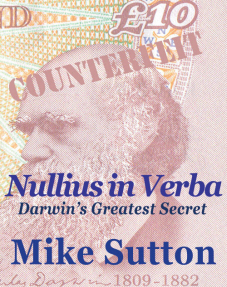
Comments Off on Is this the Shocking Origin of “Easter Eggs”?
On April Fools Day
April 1st, 2015By Mike Sutton
There are many competing explanations for the cultural origins of April fools day.
Wikipedia has it that: “In 1508, French poet Eloy d’Amerval referred to a poisson d’avril (April fool, literally “April fish”), a possible reference to the holiday. In 1539, Flemish poet Eduard de Dene wrote of a nobleman who sent his servants on foolish errands on 1 April. In 1686, John Aubrey referred to the holiday as “Fooles holy day”, the first British reference. On 1 April 1698, several people were tricked into going to theTower of London to “see the Lions washed”.”
Today, April 1st 2015, no joke, honestly, with the ID research method, I found what appears to be the first English use of the term “April fools”:
“April fools – People sent on idle errands.”
Source:Ray, J. (1678) A Collection of English Proverbs. W, Morden, Cambridge University.
F. Ray is described as being a Fellow of the Royal Society. From his work, including a book on birds and another on poisons he appears to have been something of a polymath.
To find out how to find early uses of terms, phrases and words with the remarkable ID method – see first free chapters of Nullius in Verba
Comments Off on On April Fools Day
Dawkinite Discovered: Is the “God Delusion” Game up for Richard Dawkins?
March 28th, 2015
By Mike Sutton.
The Dawkinite Meme is that Richard Dawkins, along with other prominent atheist Darwinists, believes in miracles but vociferously criticizes religions for encouraging people to believe in miracles. Allow me to explain why:
At the most basic level, a miracle depends upon its happening being such a highly improbable event that only a supernatural explanation could account for it being veracious. The Virgin Mary’s conception of Jesus of Nazareth being fathered by a supernatural deity, whilst surrounded by fertile men, is one example of Christian miracle belief in just such an improbable event, which they believe really happened.
It is newly discovered that Matthew’s prior publication of the entire theory was read, and cited by their own friends and associates, who they admitted highly influenced them. Despite this bombshell discovery, Darwinists really do continue to credulously believe that Darwin and Wallace discovered Natural Selection theory independently of it’s cited and reviewed prior-publication .
Is Dawkinite a gift from God? Is Dr Richard Dawkins serving the world as God’s unwitting atheist apostle? Full details of the 2015 discovery of Dawkinite can be found on the BestThinking site
Comments Off on Dawkinite Discovered: Is the “God Delusion” Game up for Richard Dawkins?
Darwinists Failing in Desperate Attempts to Defend Namesake Against New Data
March 23rd, 2015
By Mike Sutton.
Since August 2104, following the publication of my e-book Nullius in Verba , I have been presented with a number of attempted defenses against newly discovered data.

The New Data proves that Darwin’s friends and associates read Patrick Matthew’s (1831) book: On Naval Timber and Aboriculture, containing the full prior-published hypothesis of natural selection.
Contrary to what some Darwinists have argued online in defense of their namesake, it really is possible to 100 per cent disprove something. Because the New Data 100 per cent disproves the prior Darwinist myth (started by Darwin in 1860) that no naturalists known to him or Wallace read Matthew’s book. In fact, it is newly discovered that seven naturalists cited it in the literature. Four of the “citing-seven” were known to Darwin, and three of them played major roles at the epicenter and facilitation of the pre-1858 work of Wallace and Darwin on the exact same subject. The only way this could be refuted is if someone discovers that there has been a massive “invasion of the book snatchers” hoax that involved seeding fake 19th century science books in libraries, bookshops and homes throughout the world. Just how probable (or even possible) is that?
The Darwinist prior ‘mere knowledge belief’ that Darwin and Wallace ‘independently discovered’ Matthew’s prior-published hypothesis is dis-confirmed by the newly discovered fact that those around Darwin and Wallace, and known to them, had read and cited the one book in the world they most needed to read because they replicated so much that was in it, while later claiming that neither they nor anyone known to them had read it.
As well as the hypothesis of natural selection, both Darwin (1844 and 1859) and Wallace (1858) replicated Matthew’s unique and groundbreaking artificial selection explanatory analogy. In his unpublished essay of 1844, Darwin wrote to replicate that exact expert forester and arboriculturalist example.
‘In the case of forest trees raised in nurseries, which vary more than the same trees do in their aboriginal forests, the cause would seem to lie in their not having to struggle against other trees and weeds, which in their natural state doubtless would limit the conditions of their existence…’
Unlike Matthew, Darwin was not an expert on that topic. So, if not from the expert, Matthew who had uniquely prior-published it, where did Darwin get it? Perhaps from David Lowe – Matthew’s old schoolmate – who replicated the analogy without citing Matthew, shared Matthew’s publishers and was apparently first to replicate apparently unique Matthew coined terms in his books, which all followed Matthew’s book of 1831? Perhaps so, because Darwin successfully recommended Lowe to the Royal Society precisely for his work on the use of artificial selection to explain natural selection. In either scenario, direct or else indirect, Matthewian to Darwin knowledge contamination appears far more likely than not.
A typology of knowledge contamination
If Darwin and Wallace ‘independently’ discovered Matthew’s hypothesis, and so many of his unique ideas, examples and terms, under such social conditions, surrounded by men whose minds were to some unknown extent, fertile with Matthew’s ideas (because we know they read the book containing them), then a miracle happened that has its analogue in the Christian belief in The Blessed Virgin’s Immaculate conception, by their “God”, of the baby Jesus. Perhaps someone – the Pope perhaps – will tell Richard Dawkins, famous atheist Darwin deifying author of The God Delusion, that he is actually, albeit unwittingly, serving as Gods’ atheist apostle, his wonders to perform?
More likely than not, no miraculous virgin-brain conception took place. Rationally, scientists are more likely to conclude, in light of the New Data that Darwin’s and Wallace’s associates did read Matthew pre-1858, that some degree of Matthewian knowledge contamination took place to cause Darwin’s and Wallace’s conceptions and replications of Matthew’s unique prior discovery.
Darwinist defenses against the likelihood of knowledge contamination taking place are all refutable with reason, logic and hard facts. The most up-to-date Darwinist defenses against the New Data – each followed by an evidence-led rebuttal can be found on the BestThinking website.
Comments Off on Darwinists Failing in Desperate Attempts to Defend Namesake Against New Data
Evidence Shows Darwin Plagiarized Prior Discovery of Natural Selection
December 30th, 2014By Mike Sutton.
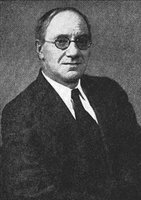
In 2010, Professor Richard Dawkins – the leading Darwinist expert on evolution by natural selection – wrote that Patrick Matthew was in 1831 the first person to publish the full hypothesis of natural selection. But Dawkins is adamant in his beliefs that both Charles Darwin and Patrick Matthew discovered natural selection independently of Matthew’s prior-published book and independently of one another. However, in 2014 BigData technology unearthed a multitude of brand new evidence, which represents independently verifiable hard data that dis-confirms all of the mere knowledge-beliefs that Dawkins and other Darwinists have relied upon as evidenced premises of Darwin’s and Wallaces’s honesty when they claimed that neither they or any naturist known to them had any prior knowledge of Matthew’s unique ideas before 1860, the year after Darwin published The Origin of Species.
Background to new discovery
In 1913, the expert who was widely lauded as the ‘Dean of all foresters’, Professor Raphael Zon explained exactly why it is that a forester such as Patrick Matthew discovered natural selection almost 30 years before Darwin and Wallace replicated the exact the same discovery before claiming no prior knowledge of Matthew’s (1831) book containing it. Zon wrote in a peer reviewed journal article:
Is there anything strange, therefore, that it was a forester who first formulated the principles of natural selection? Is there anything strange also, in the fact that it was also foresters who laid the foundation for what has come to be known as ecology, which is the logical development of Darwinism? Because of the fact that the forest is the highest expression of plant life, the foresters occupy the strategic position from which they command vistas accessible only with difficulty to other naturalists. In this lies the strength of forestry, its peculiar beauty, and the debt which science owes it. (Zon 1913, p. 546).
Professor Loren Eiseley (1979) thought that Darwin’s replication of one of Matthew’s explanatory examples alone was sufficient proof that Darwin had read Matthew’s book
before 1844 and plagiarized Matthew’s entire discovery of natural selection . Darwin’s unpublished essay of 1844 reveals his great interest in trees as key to understanding natural selection as an analogue of artificial selection, was remarkably similar to Matthew’s discovery. Matthew, who elsewhere in NTA (p. 280-285, 366) wrote about the relative hardiness of naturally selected crab apple trees compared with artificially selected hybridized apple trees, wrote (Matthew 1831, p. 308):
‘Man’s interference, by preventing this natural process of selection among plants, independent of the wider range of circumstances to which he introduces them, has increased the differences in varieties particularly in the more domesticated kinds…
In his unpublished essay of 1844, Darwin wrote:
‘In the case of forest trees raised in nurseries, which vary more than the same trees do in their aboriginal forests, the cause would seem to lie in their not having to struggle against other trees and weeds, which in their natural state doubtless would limit the conditions of their existence…’
Wallace’s (1858) Ternate paper (contrary to the dreadful fallacy penned by Professor Bowler) also used artificial selection as a heuristic device to explain natural selection. That should not be surprising, however, since the Chief editor of the journal that published his earlier Sarawak paper (Selby – who was a famous naturalist and friend of Darwin;s father) cited Matthew’s (1831) book many times in 1844 (see Sutton 2014). And my research further uniquely reveals that Selby was by no means the only naturalist known personally to Darwin to have cited Matthew pre-1858. So much then for Darwin’s fallacious claim, parroted by credulous Darwin worshiping Darwinists for the past 154 years, that no naturalist known to him had read Matthew’s ideas before 1860.

Professor Milton Wainwright has published two important peer reviewed articles on Darwin’s likely plagiarism of Matthew here and here.
The New Data Discovered in 2014
In December 2014 the British Society of Criminology published my peer reviewed article (click here) that reveals why a host of newly discovered data – in 2014 – now means that it is more likely than not that both Darwin and Wallace did plagiarize Matthew’s book, that they lied when they claimed no prior knowledge of it and that by doing so they committed the worlds greatest science fraud.
Please click here to read the latest peer reviewed article on Darwin’s and Wallace’s plagiarism of Matthews’ discovery.
For 154 years we have been telling ourselves a great lie about the discovery of natural selection. For so long and so often has the lie been told that we
believe it to be true. Darwinists live in fear that only chaos will ensue if the truth is accepted that they are named for the worlds greatest science fraudster only because of his fraud. But chaos offers opportunities for a better world. What sort of world do you prefer to live in?
If you are interested in reading all the evidence – older and newly discovered – of Darwin’s and Wallace’s lies, plagiarism and science fraud then my e-book on the topic is
available on every Amazon site and also directly from my publisher here
Reference for Zon’s essay
Zon, R. (1913) Darwinism in Forestry. The American Naturalist. Vol. 47. No. 561. September. pp. 540-546.
Comments Off on Evidence Shows Darwin Plagiarized Prior Discovery of Natural Selection
Interview with Myles Power on What the “New Data” Means for Darwin’s Science Legacy
November 8th, 2014
By Mike Sutton.
Until the publication of Nullius in Verba (Sutton 2014), the orthodox Darwinist history of scientific discovery had it that Patrick Matthew (in
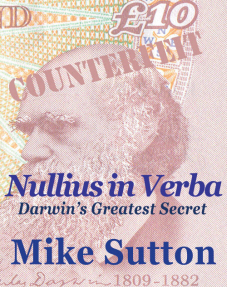
1831), Alfred Wallace (in 1855 & 1858) and Charles Darwin (between 1837 & 1859) all discovered Natural Selection independently of anyone else and independently of one another.
Click on the link below – to listen to an interview on what we might make of the newly discovered evidence that naturalists known to Darwin and Wallace DID in fact – contrary to prior history of biology and scientific discovery ‘knowledge beliefs’ – read Patrick Matthew’s prior published hypothesis of Natural Selection – and then went on to play major roles at the epicenter of influence on the pre 1858 published ideas of both Darwin and Wallace.
Click here to listen to the 2014 interview between Myles Power and Mike Sutton https://www.youtube.com/watch?v=V2uBn-gUU4c
My own conclusion that Darwin committed the World’s greatest science fraud is based on a wealth of further new evidence, which includes but is by no means limited to my further unique Big Data facilitated discoveries that Darwin told six audacious and independently verifiable lies to achieve primacy over Matthew, plagiarized his 1831 text, lobbied hard, but unsuccessfully to have the rules of of scientific priority changed so that better known scholars such as he would have priority over lesser known first discoverers if they worked out more of the details of the importance of that prior-discovery and had many years earlier engaged in unethical semi-fraudulent vainglorious misappropriation of the little-known discoveries of others.
Ultimately, it matters not one jot what I think the newly discovered data adds up to. What matters is what, dear reader and listener, you think the new data means.
Is it now more likely than not that Matthew did – in some way – influence Darwin and Wallace by ‘knowledge contamination’? If like me you do think so, then surely it does not now matter that Darwin found a host of confirming evidence for Matthew’s prior published hypothesis. Because it is, currently at least, a scientific fact that no amount of confirmatory evidence finding can transmute a prior discovery into your own.
Comments Off on Interview with Myles Power on What the “New Data” Means for Darwin’s Science Legacy
World’s Greatest Science Fraud: Darwin and Wallace newly proven to have plagiarised theory of natural slection
August 12th, 2014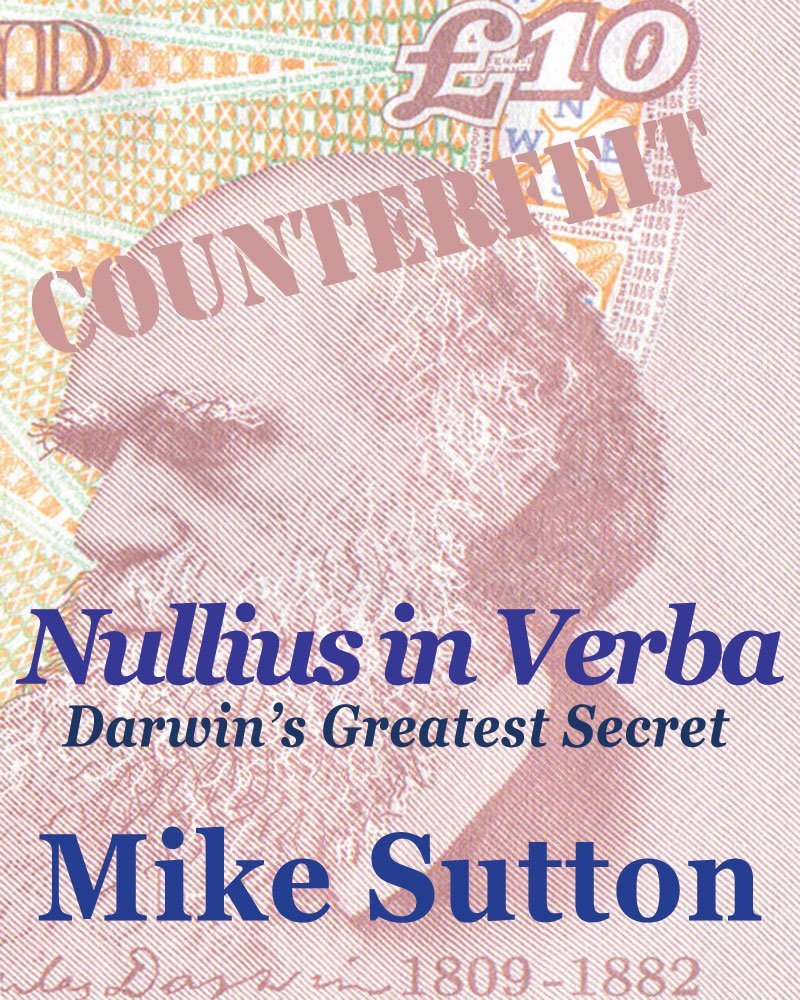
By Mike Sutton.
Just as new DNA analysis is changing traditional forensic science I recently pioneered the use of newly available “big data” analysis of the literature to expose the world’s greatest science fraud.
The great science myth, started by Darwin and Wallace, that they each ‘independently discovered the theory of natural selection with no prior knowledge of Patrick Matthew’s earlier publication of the entire detailed theory was completely disproved by big data analysis in 2014.
Darwin and Wallace claimed that they failed to hear of Matthew’s book because no naturalist known to them had read it. They lied! But for 154 years the scientific community, simply took their word for it in contravention of the most famous ancient Latin tenet of the Royal Society ‘Nullius in Verba‘ (on the word alone of no one) .
Contrary to current Darwinian “knowledge” that no one read Matthew’s book, pioneering big data analysis of 30 million+ publications reveals that before Darwin penned the ‘Origin of Species’ at least 52 people read Matthew’s (1831) book ‘On Naval Timber and Arboriculture’, 25 actually cited it in the published literature! Moreover, 19 of those who read it were in Darwin’s inner social circle! Of the seven naturalists now newly known to have cited Matthew’s book in print, three played pivotal roles at the epicentre of Darwin’s and Wallace’s published and unpublished work on natural selection before the ‘Origin of Species’ was first published in 1859.
Knowledge contamination from Matthew to Darwin and Wallace is thus uniquely proven in ‘Nullius in Verba: Darwin’s greatest secret’ – the ground-breaking book, which 100 per cent proves that Matthew influenced both Darwin and Wallace through three major naturalist who cited his 1831 book: John Loudon, Prideaux John Selby and Robert Chambers.
Fully 27 years before Darwin’s Origin of Specis was first published, Loudon reviewed Matthew’s book in 1832, writing precisely that it had something original to say on “the origin of species” no less! Loudon then went on to edit and publish Blyth’s highly influential papers of 1835 and 1837! Chambers cited Matthew’s book in 1832 before penning the famous ‘Vestiges of Creation’ in 1844. And both Darwin and Wallace admitted the huge influence of Robert Chambers’s ‘Vestiges of Creation’ on their own work in the field of natural selection. Selby, who cited Matthew’s book many times in 1842 went on to edit and publish Wallace’s famous Sarawak paper of 1855!
‘Nullius’ further proves that Darwin told six deliberate lies in order to achieve primacy over Matthew and reveals for the first time his desperate attempt to have the codified rules of scientific priority changed so that better known scientists such as he would be awarded priority over lesser known first discoverers such as Matthew. Moreover, all eight of Darwin’s excuses for why he supposedly had no prior-knowledge of Matthew’s prior-published discovery are all proven to be completely fallacious.
Having destroyed the myth of Darwin the honest gentleman of science, ‘Nullius’ examines further new bombshell discoveries in light of earlier discoveries of Darwin’s dishonesty in stealing the ideas, given in confidence, of his Edinburgh tutor, Grant, and his notorious editing of the second edition of the ‘Voyages of the Beagle’, which fuelled the myth that he discovered natural selection on the Galapagos Islands rather than a year or two later where he really found it – inside books between 1837 and 1838.
If you think Galapagos finch beaks had anything at all to do with the discovery of natural selection then you, like millions of others, have been hoodwinked by Darwin’s great science fraud.
‘Nullius in Verba: Darwin’s greatest secret’ is published by Thinker Media Inc. USA.
Mike Sutton
Comments Off on World’s Greatest Science Fraud: Darwin and Wallace newly proven to have plagiarised theory of natural slection









